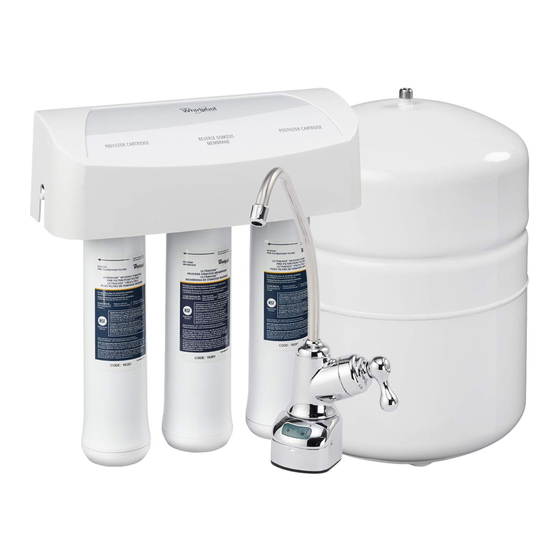
Whirlpool WHER25 Reverse Osmosis Manual
- Installation and operation manual (29 pages) ,
- Operation manual (28 pages) ,
- Performance data sheet (2 pages)
Advertisement
- 1 WARRANTY
- 2 Specifications & Dimensions
- 3 Inspect Shipment
- 4 Tools Needed
- 5 Plan Your Installation
- 6 Overview and Site Preparation
-
7
Installation Instructions
- 7.1 Install Supply Water Fitting
- 7.2 Install RO Drain Under Sink
- 7.3 Install RO Drain in Remote Location
- 7.4 Install RO Filter Assembly
- 7.5 Install Storage Tank
- 7.6 Install RO Faucet
- 7.7 Connect Tubes
- 7.8 Sanitize, Test and Purge System
- 8 How Your RO Water System Works
- 9 Maintenance
- 10 Troubleshooting
- 11 Exploded View
- 12 Parts List
- 13 Videos
- 14 Documents / Resources

Do not return unit to store
If you have any questions or concerns when installing, operating or maintaining your reverse osmosis system, call our toll free number: 1-866-986-3223 Monday- Friday, 8 AM - 7 PM EST or visit www.whirlpoolwatertreatment.com When you call, please be prepared to provide the model, date code and serial number of your product, found on the rating decal, located inside the cover.
 System tested and certified by NSF International against NSF/ANSI Standards 42 & 58. See performance data sheet for details.
System tested and certified by NSF International against NSF/ANSI Standards 42 & 58. See performance data sheet for details.
WARRANTY
ONE YEAR LIMITED WARRANTY ON REVERSE OSMOSIS DRINKING WATER SYSTEM (Except filter cartridges and R.O. membrane)
Warrantor: Ecodyne Water Systems, 1890 Woodlane Drive, Woodbury, MN 55125
Warrantor guarantees, to the original owner, that the Reverse Osmosis Drinking Water System, when installed and maintained in accordance with the instructions, will be free from defects in materials and workmanship for a period of one (1) year from the date of purchase. If, within the first year, a part proves, after inspection, to be defective, Warrantor will, at its sole option, either replace or repair the part without charge except normal shipping and installation charges. Labor to maintain the equipment is not part of the warranty. Filters and membranes, which are expendable, are not covered by the warranty.
TO OBTAIN WARRANTY PARTS, SIMPLY CALL 1-866-986-3223, Monday - Friday, 8 am - 7 pm EST, for assistance. This warranty applies only while this product is in use in the United States or Canada.
General Provisions
The above warranties are effective provided the Reverse Osmosis Drinking Water System is operated at water pressures not exceeding 125 psi, and at water temperatures not exceeding 100°F; provided further that the Reverse Osmosis Drinking Water System is not subject to abuse, misuse, alteration, neglect, freezing, accident or negligence; and provided further that the Reverse Osmosis Drinking Water System is not damaged as the result of any unusual force of nature such as, but not limited to, flood, hurricane, tornado or earthquake.
Warrantor is excused if failure to perform its warranty obligations is the result of strikes, government regulation, materials shortages, or other circumstances beyond its control.
*THERE ARE NO WARRANTIES ON THE REVERSE OSMOSIS DRINKING WTAER SYSTEM BEYOND THOSE SPECIFICALLY DESCRIBED ABOVE. ALL IMPLIED WARRANTIES, INCLUDING ANY IMPLIED WARRANTY OF MERCHANTABILITY OR OF FITNESS FOR A PARTICULAR PURPOSE, ARE DISCLAIMED TO THE EXTENT THEY MIGHT EXTEND BEYOND THE ABOVE PERIODS. THE SOLE OBLIGATION OF WARRANTOR UNDER THESE WARRANTIES IS TO REPLACE OR REPAIR THE COMPONENT OR PART WHICH PROVES TO BE DEFECTIVE WITHIN THE SPECIFIED TIME PERIOD, AND WARRANTOR IS NOT LIABLE FOR CONSEQUENTIAL OR INCIDENTAL DAMAGES. NO WARRANTOR DEALER, AGENT, REPRESENTATIVE, OR OTHER PERSON IS AUTHORIZED TO EXTEND OR EXPAND THE WARRANTIES EXPRESSLY DESCRIBED ABOVE.
Some states do not allow limitations on how long an implied warranty lasts or exclusions or limitations of incidental or consequential damage, so the limitations and exclusions in this warranty may not apply to you. This warranty gives you specific legal rights, and you may have other rights which vary from state to state. This warranty applies to consumer-owned installations only.
Specifications & Dimensions
| Supply water pressure limits | 40-100 psi (280-689 kPa) |
| Supply water temperature limits | 40-100°F (4.5-37.7°C) |
| Maximum total dissolved solids (TDS) | 2000 ppm |
| Maximum water hardness @ 6.9 pH | 10 gpg |
| Maximum iron, manganese, hydrogen sulfide | 0 |
| Chlorine in water supply (max. ppm) | 2.0 |
| Supply water pH limits (pH) | 4-10 |
| Product (quality) water, 24 hours1 | 18.4 gal. (69.6 liters) |
| Percent rejection of TDS, minimum (new membrane)1 | 68.5 |
| Automatic shutoff control | yes |
| Efficiency2 | 12.2 % |
| Recovery3 | 22.9 % |
This system conforms to NSF/ANSI 58 for the specific performance claims as verified and substantiated by test data.
1@ Feed water supply at 50 psi, 77°F, and 750 TDS --- Quality water production, amount of waste water and percent rejection all vary with changes in pressure, temperature and total dissolved solids.
2Efficiency rating means the percentage of the influent water to the system that is available to the user as reverse osmosis treated water under operating conditions that approximate typical daily usage.
3Recovery rating means the percentage of the influent water to the membrane portion of the system that is available to the user as reverse osmosis treated water when the system is operated without a storage tank or when the storage tank is bypassed.
Non-potable Water Sources: Do not attempt to use this product to make safe drinking water from non-potable water sources. Do not use the system on microbiologically unsafe water, or water of unknown quality without an adequate disinfection before or after the system. This system is certified for cyst reduction and may be used on disinfected water that may contain filterable cysts.
Arsenic Reduction: This system shall only be used for arsenic reduction on chlorinated water supplies containing detectable residual free chlorine at the system inlet. Water systems using an inline chlorinator should provide a one minute chlorine contact time before the reverse osmosis system.
Nitrate/Nitrite Test Kit: This system is acceptable for treatment of influent concentrations of no more than 27mg/L nitrate and 3mg/L nitrite in combination measured as N. It is certified for nitrate/nitrite reduction only for water supplies with a pressure of 280 kPa (40 psig) or greater. This system is supplied with a nitrate/nitrite test kit. Product water should be monitored periodically according to the instructions provided with the test kit.
TDS Test Kits: TDS test kits are available by calling 1-800-949-8220 or check the water testing section of your local phone directory.
Installations In The Commonwealth Of Massachusetts: The Commonwealth of Massachusetts requires installation be performed by a licensed plumber and do not permit the use of saddle valves. Plumbing code 248-CMR of the Commonwealth of Massachusetts must be followed in these cases.
Product Water Testing: The Reverse Osmosis system contains a replaceable treatment component critical for the effective reduction of total dissolved solids. Product water should be tested periodically to verify that the system is performing properly.
Replacement of the reverse osmosis component: This reverse osmosis system contains a replaceable component critical to the efficiency of the system. Replacement of the reverse osmosis component should be with one of identical specifications, as defined by the manufacturer, to assure the same efficiency and contaminant performance.
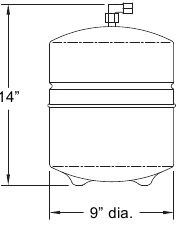
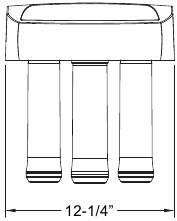
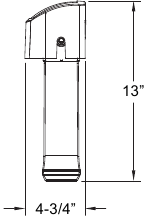
FIG. 1
Questions? Call Toll Free 1-866-986-3223 Monday- Friday, 8 AM - 7 PM EST or visit www.whirlpoolwatertreatment.com
When you call, please be prepared to provide the model, date code and serial number, found on the rating decal, located inside the cover.
Inspect Shipment
Your Reverse Osmosis Drinking Water System is shipped complete in one carton. Remove all items from your shipping carton.
Check all items against the packing list below. Note any items lost or damaged in shipment.
Note any damage to the shipping carton. Refer to the exploded view and parts list in the back of the manual for the part names and numbers of missing or damaged items. If problems exist, refer to the website or the toll free number listed throughout this manual.
Keep the small parts in the parts bag until you are ready to install them.
NOTE: Codes in the state of Massachusetts require installation by a licensed plumber and do not permit the use of saddle valves.
If you live in the state of Massachusetts, review plumbing code 248-CMR of the Commonwealth of Massachusetts before proceeding with the installation.
Packing List
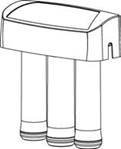
Reverse Osmosis Assembly with Red & Yellow Tubes attached
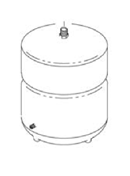
Product Water Storage Tank

Reverse Osmosis Faucet with Black & Blue Tubes attached

Green Supply Tube
Parts Bag

Hanger Brackets

Eye Dropper

Tank Connector

Coin Battery

Drain Adapter Kit

Tee, Feed Adapter

Nitrate / Nitrite Test Kit
FIG. 2
Do not return the unit to store.
If you have any questions, or there are missing parts or damage, please call Toll Free 1-866-986-3223, Monday - Friday, 8 am - 7 pm EST, or visit www.whirlpoolwatertreatment.com
When you call, please be prepared to provide the model, date code and serial number, found on the rating decal, located inside the cover.
Tools Needed
Review the tools needed list. See Fig. 3. Gather needed tools before proceeding with the installation. Read and follow the instructions provided with any tools listed here.
TOOLS NEEDED

Tape Measure

Adjustable Wrench

Philips Screwdriver

Flathead Screwdriver

Drill & Drill Bits, if required

Adjustable Large Jaw Pliers

OR Pipe Wrench
FIG. 3
Plan Your Installation
Read through the entire manual before beginning your installation. Follow all steps exactly. Reading this manual will also help you get all the benefits from your system. Your Reverse Osmosis Drinking Water System can be installed under a sink or in a remote location. Typical remote sites are a laundry room or utility room. Review the location options below and determine where you are going to install your system.
UNDER THE SINK LOCATION
The Reverse Osmosis Filter Assembly and storage tank may be installed in a kitchen or bathroom sink cabinet. See Fig. 4.
A suitable drain point is needed for drain water from the Reverse Osmosis system.
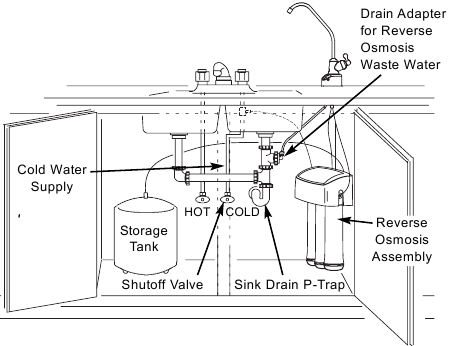
Typical Under Sink Installation
All install parts included in package.
FIG. 4
REMOTE INTERIOR LOCATION
The Reverse Osmosis Filter Assembly and storage tank may also be installed in a remote interior location away from the Reverse Osmosis Faucet. You will need a nearby watersource and drain point. See Fig. 5.
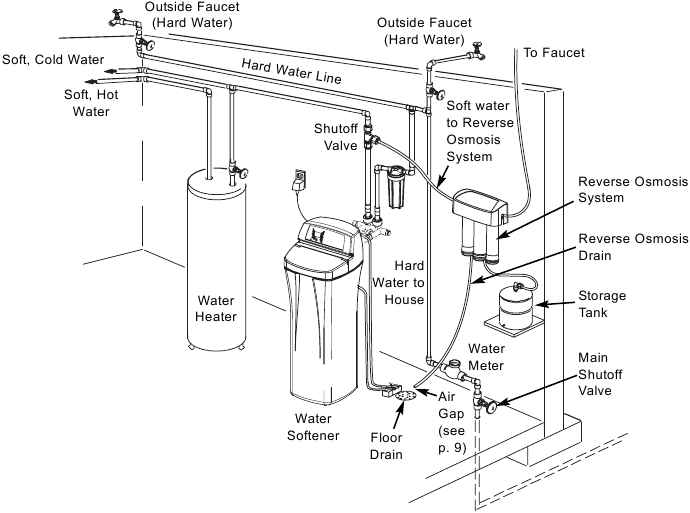
Typical Remote Installation
Additional parts required.
FIG. 5
CHECK SPACE REQUIREMENTS
Check size and position of items for proper installation into location chosen.
NOTE: For best system performance, the feed water to the system should be softened or have hardness less than 10 grains per gallon, with no iron.
Overview and Site Preparation
OVERVIEW
Read through the entire manual before beginning your installation. There are seven steps to installing your Drinking Water system. They are as follows:
STEP A - Install Cold Water Supply Fitting
STEP B - Install Drain Adapter
STEP C - Install Reverse Osmosis Assembly
STEP D - Install Storage Tank
STEP E - Install Reverse Osmosis Faucet
STEP F - Connect Tubing
STEP G - Sanitize, Pressure Test & Purge System
These steps are explained in detail over the next few sections. Follow all steps. Reading this manual will also help you receive and use all the benefits your Reverse Osmosis system can give you.
PREPARE SITE FOR INSTALLATION
- Before starting, close the hot and cold water shutoff valves (See Figure 6).
- Temporarily place tank and filter assembly intoplanned location. Check position of items and space required for proper installation. Ensure tubes may be routed without kinking.
- Remove tank and filter from planned location andset aside.
NOTE: You must check and comply with all local plumbing codes.
NOTE: Codes in the state of Massachusetts require installation by a licensed plumber and do not permit the use of saddle valves. If you live in the state of Massachusetts, review plumbing code 248-CMR of the Commonwealth of Massachusetts before proceeding with the installation.
NOTE: For best system performance, the feed water to the system should be softened or have hardness less than 10 grains per gallon, with no iron.
Installation Instructions
Install Supply Water Fitting
CHOOSE TYPE OF WATER FITTING TO INSTALL
Check and comply with local plumbing codes as you plan, then install a cold feed (supply) water fitting. Refer to the Specifications section for supply water requirements. The fitting must provide a leak-tight connection to the RO 1/4" tubing. A typical connection using the included water supply fitting is shown in Figure 6. An optional connection using standard plumbing fittings (not included) is shown in Figure 6B.
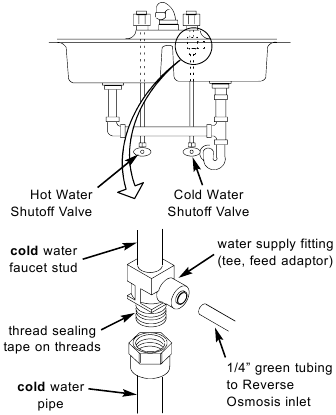
Cold Water Supply Connection
(using included water supply fitting)
FIG. 6
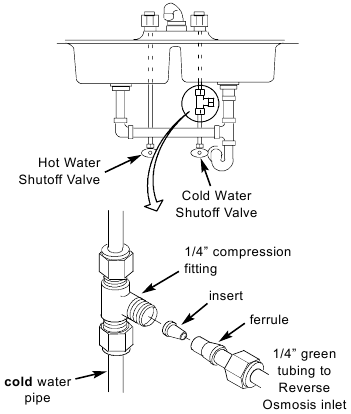
Cold Water Supply Connection
(using compression fitting - not included)
FIG. 6B
NOTE: Local code may dictate which type of water fitting is used. Consult a plumber if you are not familiar with local codes or plumbing procedures.
NOTE: Codes in the state of Massachusetts require installation by a licensed plumber and do not permit the use of saddle valves. If you live in the state of Massachusetts, review plumbing code 248-CMR of the Commonwealth of Massachusetts before proceeding with the installation.
INSTALL COLD WATER SUPPLY FITTING (Included with your package)
This fitting will be installed on the cold water pipe. The fitting must provide a leak-tight connection to the Reverse Osmosis 1/4" tubing. Locate the cold water line in the sink cabinet. It is recommended, but not required, that the cold water line be soft water.
Complete the following steps to install the water supply fitting.
- Close the water shut off valve that is immediately beforesupply fitting and open faucets to drain water from the sink cold water pipe.
- Remove nut that connects the cold water faucet to coldwater plumbing.
- Thread water supply fitting onto pipe and reconnect nutto bottom of fitting.
OPTIONAL PIPE FITTINGS (compression type shown)
NOTE: Be sure to turn off the water supply and open a faucet to drain the pipe.
Complying with plumbing codes, install a fitting on the cold water pipe to adapt 1/4" OD tubing. A typical connection isshown in Figure 6B. If threaded fittings are used, be sure touse pipe joint compound or thread sealing tape on outside threads.
Install RO Drain Under Sink
INTRODUCTION
A suitable drain point is needed for the drain water from the Reverse Osmosis Filter. You have two options to choose from:
- Install the Drain Adapter included with your unitSee Fig 7, Fig. 8, and Fig. 9. This is used in under the sink installations. The drain adapter kit is installed onto your sink drain pipe above the P-trap. See Fig. 7.
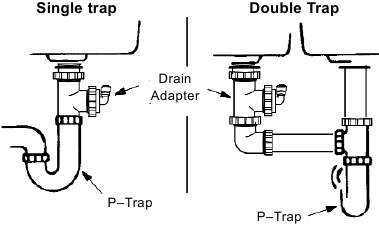
Under the Sink Installation
FIG. 7
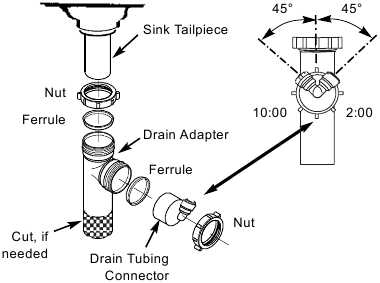
FIG. 8
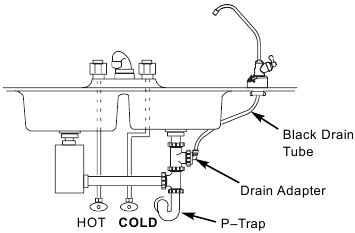
Locate drain adapter so that when the black drain tube from the Reverse Osmosis Faucet is installed it will run straight to the adapter, with no dips, loops, or kinks.
FIG. 9
- Use another existing drain in your home(See Fig 10 & 11) This is usually used in remote location type installations. The drain tube from the Reverse Osmosis Filter runs directly to an opendrain. See Fig. 10 & 11.
NOTE: An incorrectly connected drain point cancause water to leak from the faucet's air gap. FIG. 7
NOTE: Local code may dictate which type of drain installation is used. Other than local code, either drain install type may be used in both under the sink or remote location installations. Consult a plumber if you are not familiar with plumbing procedures.
INSTALL DRAIN ADAPTER KIT (Under sink Installation)
A drain adapter kit is included in your package. Review the drain adapter kit parts in Fig. 8. Install the drain adapter above or ahead of the P-trap. See Fig. 7 & 9. Be sure to comply with your local plumbing codes. The drain adapter fits 1-1/2" sink drain pipes. Other drain pipe fittings, purchased locally, may be needed in addition to the adapter.
- Slowly disassemble the sink drain pipe between thesink P-trap and the sink tailpiece. See Fig. 7 & 9.
- Clean the sink tailpiece to assure a leak-tight fit.
- Install drain adapter directly onto the sink tailpieceusing the ferrule and nut. Snug the nut, but do not tighten. See Fig. 8.
- Assemble the drain tubing connector to the drainadapter using the ferrule and nut. Snug the nut, but do not tighten. See Fig. 8.
NOTE: Locate so that the drain tubing from the Reverse Osmosis faucet will run straight to the adapter, with no dips, loops, or kinks. See Fig. 9. - Turn the connector to about 45° (10:00 or 2:00position). See Fig. 8. Tighten the nut securely.
- Assemble the P-trap to the drain adapter, and otherdrain pipe fittings as required to complete the drain run. See Fig. 7.
NOTE: If needed, you can cut the unthreaded end of the adapter to make it fit. Do not cut too short or the adapter will not make a leak-tight seal with the connecting fitting. - Tighten all connections, but do not over tighten plastic connections.
Install RO Drain in Remote Location
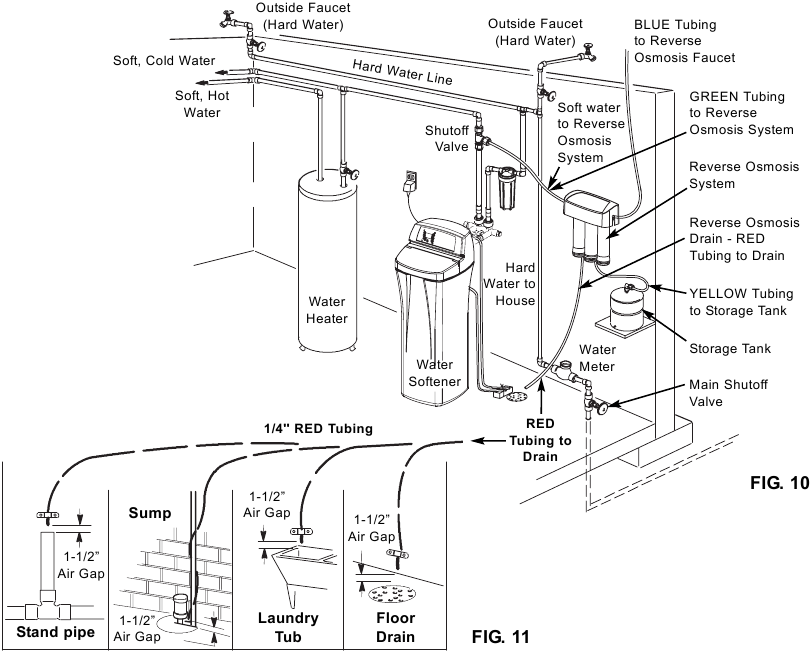
Remote Installation Location
INSTALL A REMOTE DRAIN POINT AND AIR GAP (Remote Location)
Route the drain tubing to an existing drain in the house. A floor drain, laundry tub, standpipe, sump, etc. are suitable drain points. See Fig. 11. This type of drain is the preferred over the p-trap drain adapter.
Be sure to provide a 1-1/2" air gap between the end of the hose and the drain point. This will prevent water from backing up into the system.
NOTE: Check your local plumbing codes.
To install a remote drain point, complete the following steps:
- Locate the 1/4" red tubing on the Reverse Osmosis filter assembly. See Fig. 10.
- Determine if this length is long enough to reach thedrain point. Longer lengths of tubing (see parts list in back of manual) may be needed.
- If longer tubing is required, disconnect the 1/4" redtubing and replace with an adequate length of tubing to reach the drain point. Refer to Step F later in the manual on how to disconnect and connect tubing.
NOTE: A flow control insert is located inside the elbow fitting that the drain tube connects to. Refer to Fig 28. Leave this fitting in place. - Route the tubing to the drain point and secure at theend with a bracket (not included). See Fig. 11. Provide a 1-1/2" air gap between the end of the tube and the drain. See Fig. 11.
Install RO Filter Assembly
INSTALL REVERSE OSMOSIS FILTER ASSEMBLY
The Reverse Osmosis Filter Assembly is mounted on Screw (2) hanger washers.
See Fig 12. The hanger washers allow you to lift the filter assembly from the washers without any hardware removal. When planning your installation, you need to leave room for changing filters.
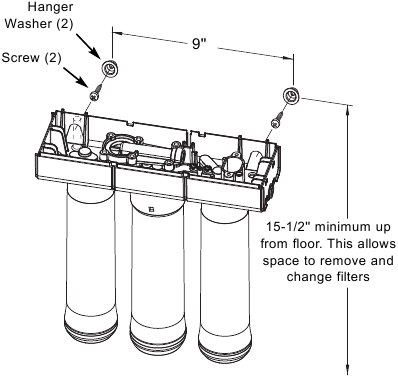
FIG. 12
Complete the following steps to install your Reverse Osmosis Filter Assembly:
- Remove the cover.
- Locate mounting slots on back inside of the assembly. See Fig 12.
- Hold the assembly up to the wall surface and marklocations for the hanger washers. See Fig 12. Mount the unit high enough to allow room to change filters without taking the unit off of the wall.
- Fasten the hanger washers to the wall using thescrews provided.
- Hang assembly on washers.
- Replace cover.
Install Storage Tank
- Apply thread sealing tape (2 wraps clockwise) to the threads on the nipple at the top of the tank. See Fig 13.
- Locate the tubing connector. See Fig. 13. Slowly tighten the tubing connector onto the tank nipple 7-8 full turns, so as not to cross thread or overtighten.
![Whirlpool - WHER25 - INSTALL STORAGE TANK INSTALL STORAGE TANK]()
FIG. 13 - Do not connect the tube at this time. This will occur later in the assembly.
- Place the storage tank next to the Reverse Osmosis Assembly. The tank can be placed upright or on its side.
Install RO Faucet
SELECT LOCATION OF REVERSE OSMOSIS FAUCET MOUNTING HOLE
You will need to select the location of the Reverse Osmosis Faucet. You have three options to choose from:
- Use the existing sink top hole for the spray hoseor soap dispenser (Must be 1-3/8" in diameter)
- Drill a new hole in the sink
- Drill a new hole in the countertop next to the sink
- Determine where you are going to install yourReverse Osmosis Faucet.
- Check to ensure the Reverse Osmosis faucet willmount flat against the mounting surface.
- Visually review the routing of the tubes from theReverse Osmosis filter assembly to the faucet. Check to ensure there is adequate tube routing
- If drilling is needed, drill a 1-3/8" diameter hole in the mounting surface.
Drilling holes into countertops and sinks should only be performed by an installer who is qualified for drilling such materials. Drilling of surfaces made of stone or solid surface materials such as granite, marble, Corian™ or other plastic resin products or sinks made of porcelain or stainless steel may cause permanent, irreparable damage to the sink or countertop surface.
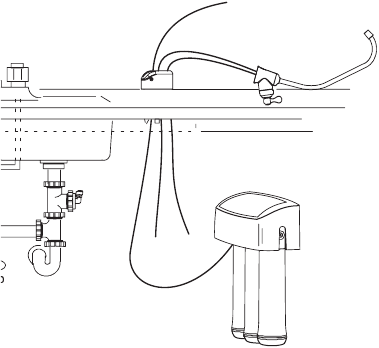
FIG. 14
INSTALL REVERSE OSMOSIS FAUCET
- Locate and organize your RO faucet install parts. Refer to Fig. 15.
![Whirlpool - WHER25 - Install RO Faucet Fig. 15 Install RO Faucet Fig. 15]()
FIG. 15 - Mount faucet base to sink hole until the faucet base is flatagainst the sink surface. The rubber gasket should be between the sink surface and the faucet base.
- Tighten the toggle bolts until the base is firmly mounted tothe sink surface. Do not overtighten.
- Locate the faucet body. (The black and blue tubes arealready connected to the faucet.) Insert these tubes into the sink hole until approximately one foot of tube length and the faucet body are left above the counter surface. Do not kink the tubes in the process. See Fig. 14.
NOTE: If you routed the red drain tubing directly to a remote drain point, disregard step 5 and move on to step 6. - Locate the 1/4" red tubing. One end is connected to theRO filter assembly. See Fig 23.
- Route the loose end of the red tube through countertopto faucet.
- Cut the loose end of the red tube square and to length. See Fig. 18 for tube cutting instructions.
NOTE: Tubing lengths should allow for the removal of the assembly from the hanger washers for servicing. If tubing lengths are shortened for neater appearance, it may be necessary to keep the assembly on the hanger washers for service. - Insert all the way onto the 1/4" faucet barb fitting onfaucet. See Figs. 16, 19 & 20.
- Pull on the tubing to be sure it is held firmly in the fit-ting.
- Mount the faucet body onto the faucet base, 1/4 turn.
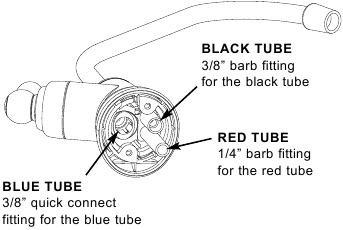
FIG. 16
FAUCET ELECTRONICS
Inside the faucet base is a battery operated 6 month timer. An amber LED indicator is also located in the front of the faucet base. This LED will flash continuously after 6 months has passed. This indicates that it is time to replace the battery, prefilter and postfilter.
INSTALL BATTERY
To install battery, complete the following steps.
- Remove the screw on the right side of the faucet base.
- Press the battery housing upward from the front faucetbase until it releases from the faucet base. See Fig. 15.
- Install the battery (CR 2032 or equivalent). Place batteryinto the holder with the positive (+) side facing the back of the holder.
- When the battery is installed the LED will flash six timesand turn off. This indicates the battery is fully charged. After the six flashes, the timer enters the 6 month time cycle.
NOTE: If the LED repeatedly flashes two times, the battery needs to be replaced. - Re-install the battery housing and firmly tighten the mount-ing screw. See Fig. 15.
Connect Tubes
HOW TO CUT AND CONNECT THE TUBES
Your Reverse Osmosis system includes push-in fittings for quick tubing connection. Review the following instructions before connecting the tubes in the next step. Failure to follow these instructions may lead to future leaks.
Cut tubes to length
- Use a sharp cutter or knife to cut the end of tubing. Always cut the tubing square. See Fig. 18.
- Inspect the tube up to 1" from the end to be surethere are no nicks, scratches or other rough spots. If needed, cut the tubing again. See Fig. 18.
NOTE: Tubing lengths should allow for the removal of the assembly from the hanger washers for servicing. If tubing lengths are shortened for neater appearance, it may be necessary to keep the assembly on the hanger washers for service.
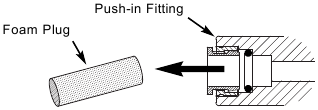
Remove and Discard Foam Plugs
FIG. 17
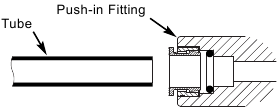
Cut tubing square with end of tubing round, smooth, with no cuts, nicks or flat spots.
Tube Corrrectly Cut
FIG. 18
Connect tubes
NOTE: Remove foam plugs before connecting tubes (See Fig. 17). Discard foam plugs.
- Push tubing through collet, until it engages the o-ring. See Fig. 19. Continue pushing until the tube bottoms out against the back of the fitting. See Fig. 20. Do not stop pushing when the tube engages the o-ring. Failure to follow these instructions may lead to future leaks. When a 1/4" tube is fully engaged, 11/16" of the tube has entered the fitting. When a 3/8" tube is fully engaged, 3/4" of the tube has entered the fitting. Mark tube with a piece of tape or marker. See Figs. 19 & 20.
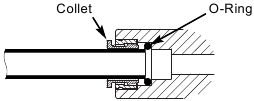
Tube Partially Engaged with Fitting
FIG. 19
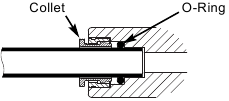
Tube Fully Engaged with Fitting
FIG. 20
- If additional tubing is required, see parts list at theend of this manual.
To Disconnect Tubes
- Push the collet inward with a finger tip. See Fig.22.
- Continue holding collet inward while pulling the tub-ing out. See Fig. 22.
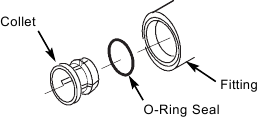
Collet and O-Ring
FIG. 21
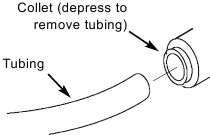
Disconnect Tubing
FIG. 22

Tube Connections
FIG. 23
NOTE: Tubing lengths should allow for the removal of the assembly from the hanger washers for servicing. If tubing lengths are shortened for neater appearance, it may be necessary to keep the assembly on the hanger washers for service.
NOTE: Codes in the state of Massachusetts require installation by a licensed plumber and do not permit the use of saddle valves. If you live in the state of Massachusetts, review plumbing code 248-CMR of the Commonwealth of Massachusetts before proceeding with the installation.
NOTE: Tube colors match collet colors.
ROUTE YELLOW TUBE TO STORAGE TANK
- Locate the yellow tube attached to the Reverse Osmosis filter assembly.
- Route the loose end of the yellow tube to the fitting on top of the storage tank. See Fig. 23.
- Cut tube square and to length. See Fig. 18.
- Do not connect at this time. This will occur in the sanitizing step.
CONNECT GREEN TUBE TO COLD WATER SUPPLY PIPE
- Route one end of the 1/4" green tube to the fitting on the water supply pipe. See Fig. 23.
- Cut tube square and to length. See Fig. 18.
- Connect to cold water supply fitting. See Fig. 6.
- Route the other end of the green tube to green collet to the fitting on the left side of the Reverse Osmosis filter assembly.
- Cut tube square and to length. See Fig. 18.
- Insert all the way into the fitting. See Figs. 19 & 20.
- Pull on the tube to be sure it is held firmly in the fitting.
CONNECT BLUE TUBE TO REVERSE OSMOSIS ASSEMBLY
- Locate the blue tube attached to the faucet.
- Route the loose end of the 3/8" blue tube to the blue collet on the right side of the Reverse Osmosis filter assembly.
- Cut tube square and to length. See Fig. 18.
- Insert all the way into the fitting. See Figs. 19 & 20.
- Pull on the tube to be sure it's held firmly in the fitting.
CONNECT BLACK TUBE FROM REVERSE OSMOSIS FAUCET TO DRAIN ADAPTER
- Locate the 3/8" black tube attached to the faucet. Fig 23.
- The loose end needs to be attached to the black collet on the sink drain adapter.
- Cut this tube as needed to route it as straight as possible, without loops, dips, or kinks.
- Cut the end of the tube square. See Fig. 18.
- Insert all the way into the fitting. See Figs. 19 & 20.
- Pull on the tube to be sure it is held firmly in the fitting.
RED TUBE TO REVERSE OSMOSIS FAUCET
The red tube connection was completed in the faucet assembly steps.
Sanitize, Test and Purge System
SANITIZE THE SYSTEM
Sanitizing is recommended immediately after installation of the Reverse Osmosis system. It's also recommended after servicing inner parts. It is important that the person installing or servicing the system have clean hands while handling inner parts of the system. Complete the following steps to sanitize the system. See Fig. 24.
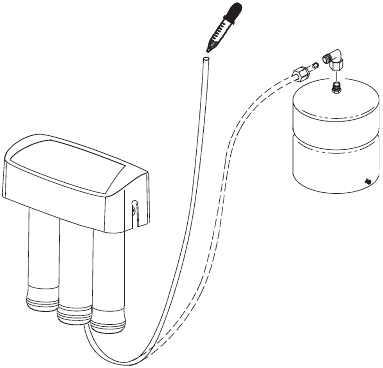
FIG. 24
- Make sure that the water supply to the Reverse Osmosis system is off.
- Open the Reverse Osmosis faucet. If the tank is not already empty, allow the water to empty.
- Locate the eyedropper included in parts bag and common household bleach (5.25%).
- Add 3 ml. of bleach into open end of yellow tubing. Handle bleach according to bleach manufacturer's recommendations. See Fig. 24.
- Connect yellow tubing to tank connector. See Figs. 13 and 24.
- Sanitizing the system will be completed during the pressure test and purging steps below.
NOTE: The bleach must be removed from the system before drinking the water. See purging instructions below.
Manufacturer recommends using the Model 7301203 Sanitizing Kit
This reusable sanitizing kit (not included) is recommended to easily and completely sanitize your Reverse Osmosis system annually.
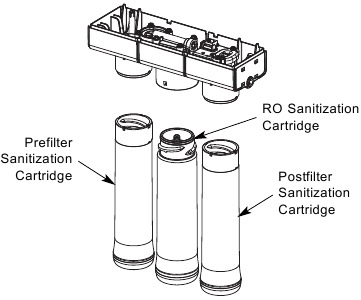
The kit includes the following:
- Prefilter sanitization cartridge (contains no filtration media)
- Postfilter sanitization cartridge (contains no filtration media)
- RO sanitization cartridge (contains no RO membrane)
- Syringe, 1 oz.
- Complete instructions
Uses standard 5.25% household bleach (not included) to completely sanitize the Reverse Osmosis system.
To order, go to www.whirlpoolwatertreatment.com and click on the "Replacement Parts" link under the "Owner Center" tab, or call toll free 1-866-986-3223 Monday - Friday, 8 AM - 7 PM EST
PRESSURE TEST THE SYSTEM
NOTE: Complete the sanitizing procedures before pressure testing.
To pressure test the system, complete the following steps.
- Open the water supply valve to the Reverse Osmosis system.
- Purge air from the house plumbing by opening several house faucets. Close faucets when water runs smooth, with no spurting.
- Pressure will start to build in the RO system. Inabout 2 hours check all fittings and connections. Check for water leaks. Fix leaks if any are found. If problems exist, refer to the troubleshooting chart or call the toll free number.
NOTE: When the system is first pressurized, water may ''spurt'' from the faucet air gap hole until air is expelled from the RO system.
Please review the following operating features before using your Reverse Osmosis system:
You will not have filtered water immediately. It may take several hours to fill the storage tank and create maximum flow from the Reverse Osmosis faucet.
Water Pressure from the Reverse Osmosis faucet will be less than your standard faucet.
Water will run to the drain while the Reverse Osmosis system is producing water, even if you are not drawing water from the Reverse Osmosis faucet. You may hear a small quantity of water going to the drain at times when water is not being used. This is normal. Water going to the drain will automatically shut off when the storage tank is full.
PURGING THE SYSTEM
To purge the system, complete the following steps.
- Open the Reverse Osmosis Faucet and let water flow through the system for a 24 hour period. Water flow will be a slow trickle at this time.
NOTE: Do not consume water from the RO system until purging is complete. - Close the Reverse Osmosis faucet after the 24 hourpurging period is complete.
- When the purging is finished, your Reverse Osmosis system is ready for use.
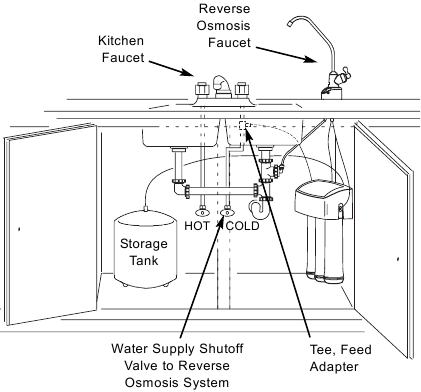
FIG. 25
NOTE: Codes in the state of Massachusetts require installation by a licensed plumber and do not permit the use of saddle valves.
If you live in the state of Massachusetts, review plumbing code 248-CMR of the Commonwealth of Massachusetts before proceeding with the installation.
NOTE: As with all other water system applications, leaks may occur. Because the system pressure builds slowly, leaks may not be immediately apparent. Recheck for leaks 24 hours after purging the system is complete.
How Your RO Water System Works
HOW YOUR REVERSE OSMOSIS SYSTEM WORKS
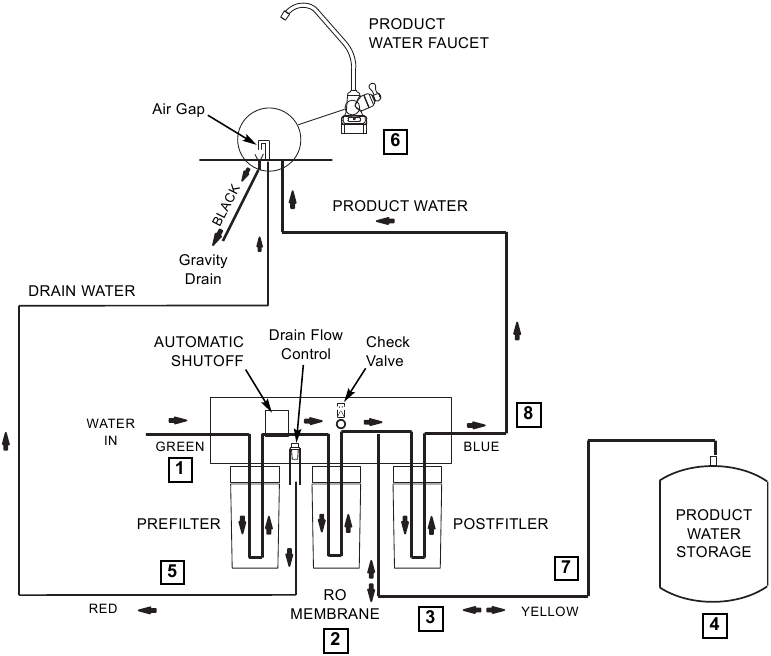
Reverse Osmosis Water Flow Schematic
FIG. 26
Introduction: Your Reverse Osmosis (RO) Drinking Water System uses your household water pressure to force water through three filters. Minerals and impurities are filtered out. Delicious tasting drinking water goes to the storage tank-ready for your use. Minerals and impurities are sent down the drain. The following paragraphs will explain in detail how your Reverse Osmosis Drinking Water System works.
Prefilter: Water from the cold supply pipe enters the prefilter. See Fig. 26. The prefilter is a replaceable sediment cartridge with activated carbon in its composition. The cartridge reduces taste, odor, sand, silt, dirt, other sediments, and up to the amount of chlorine shown in the specifications.
Reverse Osmosis Cartridge: Filtered water flows from the prefilter to the Reverse Osmosis membrane cartridge. See Fig. 26. The Reverse Osmosis cartridge is a tightly wound special membrane. The membrane reduces the dissolved solids and organic matter. High quality product water (about one ounce per minute) exits the Reverse Osmosis cartridge. The product water flows to the storage tank, postfilter or Reverse Osmosis faucet. Drain water, with the dissolved solids and organic matter, is routed to the drain.
Storage Tank: The storage tank holds product water. See Fig. 26. A diaphragm inside the tank holds water pressurized to about half of supply water pressure when the tank is full. This provides fast flow to the Reverse Osmosis faucet. When the tank is empty of water, the pressure at the air valve is 5 - 7 psi.
Postfilter: Water goes through the postfilter before going to the Reverse Osmosis faucet. See Fig. 26. The postfilter is an activated carbon type filter. Any remaining tastes and odors are reduced from the product water. Clean, high quality drinking water is available at the faucet.
Reverse Osmosis Faucet: The sink or countertop faucet has a hand operated knob to dispense drinking water. See Fig. 26. An air-gap is built into the faucet drain water connection to comply with plumbing codes.
Faucet Electronics: Inside the faucet base is a battery operated 6 month timer. See Fig. 15. An amber LED indicator is located in the front of the faucet base. This LED will flash continuously after 6 months have passed. This indicates that it is time to replace the battery, prefilter and postfilter.
Shutoff Assembly: The unit has an automatic shutoff system to conserve water. When the storage tank has filled to capacity, and the drinking water faucet is closed, pressure closes the shutoff to stop flow to the drain. After enough drinking water is used, pressure in the system drops, and the shutoff opens to allow the tank to be refilled. See Fig. 26.
Check Valve: A check valve is located in the Reverse Osmosis manifold above the center cartridge. The check valve prevents a backward flow of product water from the storage tank to drain. A backward flow could damage the Reverse Osmosis Membrane. See Fig. 26.
Flow Control: Water flow to the drain is restricted by the flow control. It maintains the desired flow rate to obtain the highest quality drinking water. The flow control is located inside the elbow fitting on the Reverse Osmosis manifold drain port. See Fig. 26.
Water Flow Description
- Water enters prefilter. Sand, silt and other sediments are reduced. Chlorine is also reduced. See Fig. 26.
- Water leaves prefilter and proceeds to the Reverse Osmosis Cartridge.
- Water enters the Reverse Osmosis membrane. Dissolved solids are reduced.
- Processed water leaves the Reverse Osmosis Membrane and flows to the storage tank.
- Drain water with dissolved solids leaves the Reverse Osmosis membrane and flows to the drain.
- Faucet is activated.
- Processed water leaves the storage tank and flows to the postfilter, where it is filtered to ensure fresh taste.
- Water flows to the Reverse Osmosis faucet.
Maintenance
PREFILTER / POSTFILTER MAINTENANCE
NOTE: It is recommended to replace the battery, prefilter and postfilter cartridges at least every 6 months of product water use. Replace more often if they begin to plug with sediment.
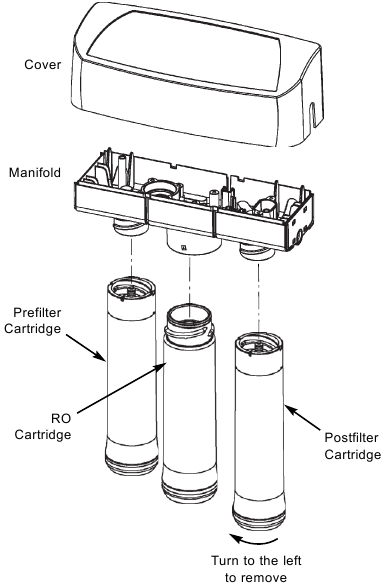
FIG. 27
The prefilter and postfilter are replaceable sediment cartridges with activated carbon in their composition. See Fig. 27. You must periodically replace the prefilter and postfilter cartridge. This will protect the RO membrane from being destroyed by chlorine. It will also prevent the filters from plugging with sediment.
You may notice a slower output of product water as the prefilter and postfilter build up with sediment. Replace the prefilter and postfilter cartridges when this occurs. You should replace the battery whenever you replace the cartridges.
RO MEMBRANE CARTRIDGE MAINTENANCE
The Reverse Osmosis cartridge is a tightly wound special membrane. See Fig. 27. The membrane reduces the dissolved solids and organic matter. The life of the Reverse Osmosis membrane cartridge depends mostly on the pH and hardness of the supply water (see Specifications). Cartridge life is shorter with higher pH. For example, if supply water pH is from 6.8 to 7.7, the cartridge may last for well over one year. However, cartridge life may be as short as 6 months if the pH is as high as 8.5 to 10. Higher pH weakens the cartridge membrane and causes pin-hole leaks. It's time to replace the Reverse Osmosis cartridge when the production rate and/or quality of product water drops. Product water may begin to taste different, indicating solids and organics are passing through the Reverse Osmosis membrane. See Reverse Osmosis cartridge replacement.
REVERSE OSMOSIS CARTRIDGE REPLACEMENT
Complete the following steps to replace the cartridges.
NOTE: Do not remove manifold from mounts. Flexing or twisting may damage the manifold.
- Remove (turn to the left) the prefilter cartridge from the manifold to stop flow to the Reverse Osmosis cartridge.
- Remove the Reverse Osmosis cartridge.
- Remove the postfilter cartridge.
- Discard the cartridges in a proper manner.
- Install new cartridges in reverse order (post filter, Reverse Osmosis and then prefilter). Turn cartridges to the right to reattach to the filter heads. Do not overtighten.
- Remove and replace the timer battery.
- Purge the Reverse Osmosis system.
Register for reminders to change filters at www.whirlpoolwatertreatment.com
PREFILTER / POSTFILTER CARTRIDGE REPLACEMENT
Complete the following steps to replace the cartridges.
NOTE: Do not remove manifold from mounts. Flexing or twisting may damage the manifold.
- Remove the prefilter cartridge (turn to the left) from the filter head. Then remove the postfilter cartridge.
- Discard the cartridges in a proper manner.
- Install new cartridges in reverse order (postfilter first, then prefilter). Turn cartridges to the right to reattach to the filter heads. Do not overtighten.
- Remove and replace the timer battery.
- Purge the Reverse Osmosis system.
FLOW CONTROL
The flow control is required for proper operation of the Reverse Osmosis system. See Fig. 28. The flow control, located inside the push-in elbow fitting on the drain port of the system housing, keeps water flowing through the membrane at the required rate. This ensures that the system produces the best quality product water.
Periodically check the flow control to be sure the small hole through it is clean and unrestricted.
If the flow control requires service, review the exploded view in Fig. 28. Assemble and disassemble as shown. If the flow control remains in the manifold when the push-in elbow fitting is removed, you will need to remove the drain port's collet and o-ring, as shown in the next section, to retrieve it.
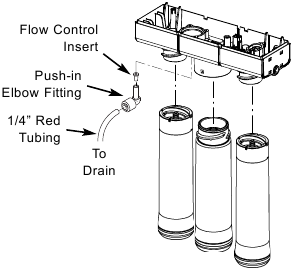
FIG. 28
CHANGE COLLET AND O-RING
- Remove the collet and o-ring from the fitting with a small screwdriver. Do not scratch the internal walls of the collet port. See Figs. 29 & 30.
- Clean collet port, lubricate with silicone-based lubricant, and insert the o-ring seal into the bottom of the port. See Figs. 29 & 30.
- Push the collet inward until it locks in place. See Figs. 29 & 30.
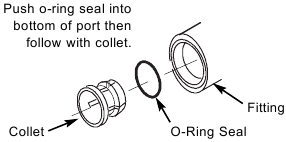
Change Collet and O-Ring
FIG. 29
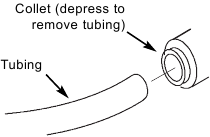
Disconnect Tubing
FIG. 30
CHANGE BATTERY
To change battery, complete the following steps.
- Remove the screw on the right side of the faucet base. See Fig. 31.
- Press the battery housing upwards from the front faucet base until it releases from the faucet base. See Fig. 31.
- Replace the battery (CR 2032 or equivalent). Place battery into the holder with the positive (+) side facing the back of the holder.
- When the battery is installed the LED will flash six times and turn off. This indicates the battery is fully charged. After the six flashes, the timer enters the 6 month time cycle. If it repeatedly flashes two times, it is not a fully charged battery.
- Re-install the battery housing and firmly tighten the mounting screw. See Fig. 31.
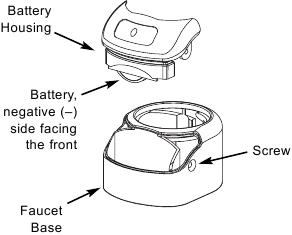
FIG. 31
Troubleshooting
| Problem: Chlorine taste and/or odor in the RO product water. | |
| Cause: The level of chlorine in your water supply exceeds maximum limits, and has destroyed the Reverse Osmosis membrane. | Correction: If the water supply contains more than 2.0 ppm of chlorine, additional filtering of the water supply to the Reverse Osmosis is needed. Contact your local water supplier. Correct this condition before doing maintenance on the Reverse Osmosis system. |
| Cause: The prefilter is no longer reducing chlorine from the water supply. | Correction: Replace the prefilter, postfilter and Reverse Osmosis membrane cartridges. |
| Problem: Other taste and/or odor. | |
| Cause: Postfilter expended. Cause: Reverse Osmosis membrane cartridge expended. | Correction: Replace the postfilter cartridge. If taste and odor persist, replace the prefilter cartridge and Reverse Osmosis membrane cartridge. |
| Cause: Contamination in product water storage tank. | Correction: Use sanitizing procedures. Replace prefilter and postfilter cartridges. |
| Cause: System contamination. | Correction: Sanitize entire system. Call 1-866-986-3223 for instructions. |
| Problem: System makes product water too slowly. | |
| Cause: Water supply to the Reverse Osmosis system not within specifications. | Correction: Increase water pressure, precondition the water, etc., as needed to conform before doing maintenance on the Reverse Osmosis system. |
| Cause: Prefilter or Reverse Osmosis membrane cartridges plugged with sediment. | Correction: Replace the prefilter cartridge. If rate does not increase, replace the postfilter cartridge and Reverse Osmosis membrane cartridge. |
| Problem: System makes lower amount of product water than usual. | |
| Cause: Storage tank air-charge less than 5-7 psi. | Correction: Open Reverse Osmosis faucet and drain tank until flow slows to a drip. Keep faucet open and check tank pressure. If low, pressurize to 6 psi. Close faucet to refill the tank. |
| Problem: High total dissolved solids (TDS) in product water. | |
| Cause: Water supply to the Reverse Osmosis system not within specifications. | Correction: Increase water pressure, precondition the water, etc., as needed to conform before doing maintenance on the Reverse Osmosis system. Correction: Send treated and untreated water samples to a water analysis lab for testing. It is important to test both the treated and untreated water to determine system performance. If the TDS is not within the system's performance guidelines, replace the prefilter, post filter and RO membrane cartridges. |
| Cause: Plugged drain flow control insert. | Correction: Replace drain flow control insert. |
| Problem: Continual water flow to drain and low or no water production. | |
| Cause: Missing flow control insert in drain port. | Correction: Make sure flow control insert is in place. |
| Problem: Water leaking from faucet airgap hole. | |
| Cause: Drain side of faucet airgap (3/8" black tubing) plugged, restricted or incorrectly connected to drain point. | Correction: Inspect and eliminate restriction or plug. Check that drain line is routed properly. Refer to installation instructions for proper drain connection. |
| Problem: Faucet LED indicator light does not function after battery change. | |
| Cause: Battery dead. | Correction: Replace with new battery. |
| Cause: Battery installed incorrectly. | Correction: Install battery correctly. |
| Problem: Water leaks at push connect fittings. | |
| Cause: Tubing not cut square. | Correction: Cut tubing square. |
| Cause: Tubing not pushed in all the way. | Correction: Push tubing in all the way. |
| Cause: Tubing nicked. | Correction: Remove tube from connection. Remove nicked portion by cutting tube to shorter length. Reinsert in connection. If removing the drain line, leave in place the elbow fitting that it connects to. |
| Cause: Outer tubing surface finish not smooth. | Correction: Remove tube from connection. Remove problem area by cutting tube to shorter length. Reinsert in connection. If removing the drain line, leave in place the elbow fitting that it connects to. |
Need help troubleshooting?
Call Toll Free 1-866-986-3223 Monday- Friday, 8 AM - 7 PM EST or visit www.whirlpoolwatertreatment.com
Exploded View
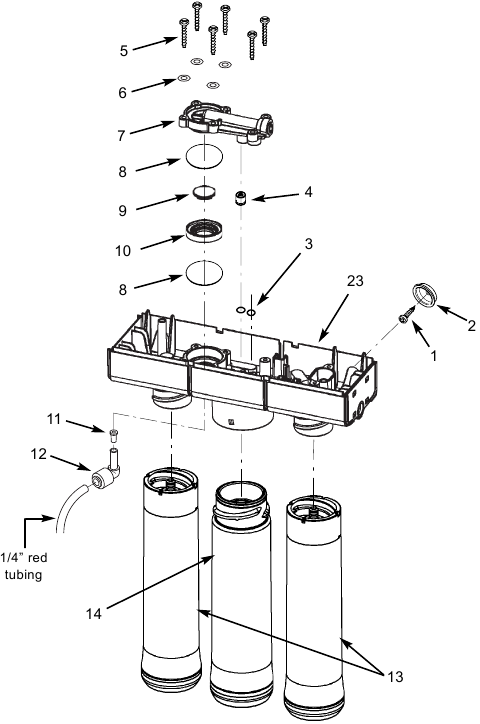
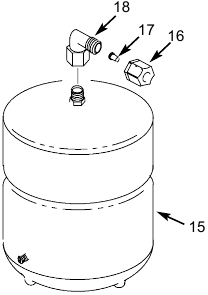
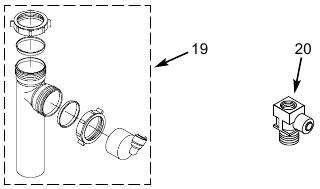
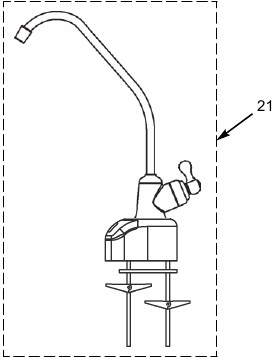
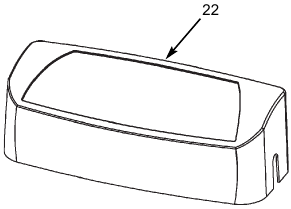
Parts List
| Key No. | Part No. | Description |
| – | 7333129 | Mounting Hardware Kit (includes 2 ea. of Key Nos. 1 & 2) |
| 1 |  | Screw (2 req'd) |
| 2 |  | Hanger Washer (2 req'd) |
| – | 7333137 | Check Valve Kit (includes Key No. 4 & 2 of Key No. 3) |
| 3 |  | O-ring, Auto. Shutoff Cover (2 req'd) |
| 4 |  | Check Assembly |
| – | 7333145 | Automatic Shutoff Kit (incl. Key No. 7, 4 of Key No. 6 & 6 of Key No. 5) |
| 5 |  | Screw (6 req'd) |
| 6 |  | Washer (4 req'd) |
| 7 |  | Automatic Shut-off Cover Assembly |
| – | 7333179 | Diaphragm Kit (includes Key Nos. 9, 10 & 2 of Key No. 8) |
| 8 |  | Diaphragm (2 req'd) |
| 9 |  | Plunger |
| 10 |  | Spacer Ring |
| – | 7333153 | Flow Control Kit (includes Key Nos. 11 & 12) |
| 11 |  | Flow Control Insert |
| 12 |  | Elbow, Plug-in, 1/4 Stem x 1/4 Tube |
| 13 | WHEERF | Pre & Post Filter Cartridge  |
| 14 | WHEERM | RO Membrane Cartridge  |
| 15 | 7205326 | Storage Tank |
| – | 7333161 | Tank Connector Kit (includes Key No. 16-18) |
| 16 |  | Nut, 3/8" Tubing |
| 17 |  | Insert, 3/8" Tubing |
| 18 |  | Connector, 1/4 NPT x 3/8 Jaco |
| 19 | 7208489 | Drain Adapter |
| 20 | 7227310 | Tee, Feed Adapter |
| 21 | 7292682 | Faucet, with base and electronics |
| 22 | 7272755 | Cover (order decal below) |
| 23 | 7285368 | Repl. Head Assembly (includes Key Nos. 3-10) |
| ■ | 7275410 | Decal, Cover |
| ■ | 7301203 | Sanitization Kit ● |
| ■ | 7315189 | Auxiliary Storage Tank ● |
| ■ | 7161823 | Tubing, 1/4" x 20' - white ▲● |
| ■ | 7157280 | Tubing, 3/8" x 20' - white ▲● |
| ■ | 7314183 | Coin Battery |
| ■ | 7279749 | Dropper |
 Please purchase replacement cartridges from the retailer where you bought your reverse osmosis system.
Please purchase replacement cartridges from the retailer where you bought your reverse osmosis system.
 Not illustrated.
Not illustrated.
 Not included.
Not included.
 Tubing lengths for remote installations, direct replacement for colored lengths of tubing.
Tubing lengths for remote installations, direct replacement for colored lengths of tubing.
NOTE: Codes in the state of Massachusetts require installation by a licensed plumber and do not permit the use of saddle valves.
To order repair parts call toll free 1-866-986-3223, Monday - Friday, 8 am - 7 pm EST.
Manufactured and warranted by Ecodyne Water Systems 1890 Woodlane Drive Woodbury, MN 55125
® / TM © 2013 Whirlpool. All rights reserved.
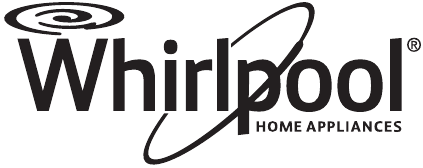
VideosWhirlpool WHER25 - How to replace reverse osmosis filter (video)
Documents / Resources
References
Download manual
Here you can download full pdf version of manual, it may contain additional safety instructions, warranty information, FCC rules, etc.
Advertisement
Thank you! Your question has been received!

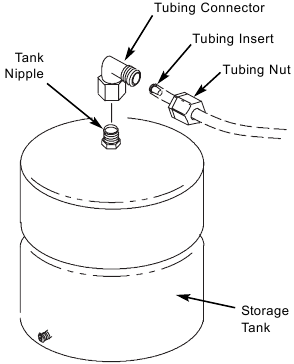
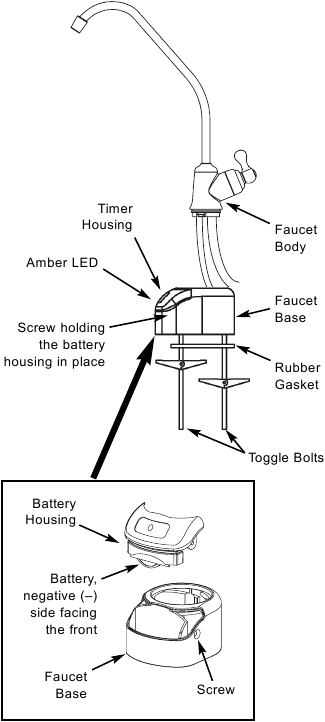




















Need Assistance?
Do you have a question about the WHER25 that isn't answered in the manual? Leave your question here.